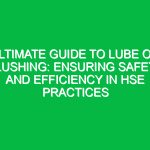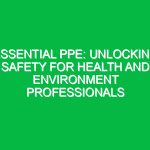Understanding PPE Means in HSE Context
Personal Protective Equipment (PPE) means encompass a wide array of gear and clothing designed to protect individuals from various hazards in the workplace. In the context of Health, Safety, and Environment (HSE), PPE plays a vital role in minimizing risks associated with occupational hazards. These hazards can range from chemical exposure and physical injuries to environmental dangers. The significance of PPE means cannot be overstated; they are essential for ensuring the safety of workers, promoting health, and safeguarding the environment.
To understand the relevance of PPE means in HSE, consider that every workplace presents unique challenges. For instance, construction sites face risks such as falls and equipment injuries, while laboratories contend with chemical spills and exposure. The right PPE means can make the difference between a safe work environment and one fraught with danger. This article will delve into the various types of PPE means, their importance, regulations governing their use, and best practices for implementation.
Types of PPE Means
PPE means can be categorized into several types, each serving a unique purpose in ensuring worker safety. Here are the primary categories:
1. Head Protection
Head protection includes hard hats and helmets designed to shield against impact, falling objects, and electrical hazards. For example, in construction environments, workers are often at risk of head injuries from overhead activities. A hard hat not only protects the skull but also can be equipped with additional features like visors and earmuffs for enhanced safety.
2. Eye and Face Protection
Eye protection encompasses safety goggles, face shields, and safety glasses that guard against chemical splashes, flying debris, and harmful radiation. In a manufacturing setting, a worker operating a milling machine may be exposed to particles that can cause severe eye injuries. Ensuring the proper eyewear is not simply a recommendation but a necessity.
3. Respiratory Protection
Respirators and masks are crucial for protecting employees from airborne contaminants, including dust, fumes, and chemicals. In environments with poor air quality, such as painting or chemical processing facilities, appropriate respiratory protection can prevent serious health issues, including long-term respiratory diseases.
4. Hand Protection
Hand protection involves gloves made from various materials designed to prevent cuts, abrasions, chemical burns, and thermal injuries. The choice of gloves depends on the specific hazards present. For instance, in a laboratory, a chemist might use nitrile gloves to handle hazardous substances, while a construction worker might opt for leather gloves for durability.
5. Foot Protection
Foot protection includes safety boots and shoes designed to prevent injuries from heavy objects, slips, and electrical hazards. In many industrial workplaces, steel-toed boots are a standard requirement to protect the feet from crush injuries.
6. Body Protection
Body protection refers to coveralls, vests, and aprons that shield workers from various hazards. In environments where chemicals are handled, specialized clothing can prevent skin exposure to harmful substances, ensuring the worker’s safety.
The Importance of PPE Means in HSE
PPE means are crucial for several reasons:
1. Injury Prevention
The primary goal of PPE means is to prevent injuries and illnesses in the workplace. For example, in a manufacturing setup, the correct use of PPE can significantly reduce the likelihood of accidents. According to the Bureau of Labor Statistics, workplaces that enforce PPE usage see a marked decrease in injury rates.
2. Legal Compliance
Many countries have established regulations and standards that mandate the use of PPE in specific industries. For instance, the Occupational Safety and Health Administration (OSHA) in the United States requires employers to provide appropriate PPE to workers. Failure to comply can result in fines and legal repercussions for employers, emphasizing the need for adherence to safety protocols.
3. Environmental Protection
PPE means are not solely about personal safety; they also play a role in environmental protection. For example, workers in waste management must wear specialized PPE to handle hazardous materials safely, preventing environmental contamination and ensuring that the surrounding ecosystem is not compromised.
4. Enhanced Workplace Morale
When employees feel safe, their morale tends to improve. Providing the necessary PPE means fosters a culture of safety, showing workers that their health and well-being are prioritized. This, in turn, can lead to increased productivity and job satisfaction.
Best Practices for Implementing PPE Means
To maximize the effectiveness of PPE means in the workplace, consider the following best practices:
1. Conduct Risk Assessments
A thorough risk assessment is the foundation of effective PPE usage. By identifying potential hazards in the workplace, employers can select appropriate PPE means tailored to the specific risks. This proactive approach ensures that workers are adequately protected.
2. Provide Training
Proper training is essential to ensure that workers understand how to use PPE means effectively. Training sessions should cover the correct usage, maintenance, and limitations of the equipment. For example, a worker may need to learn how to properly fit and wear a respirator to ensure it provides adequate protection.
3. Regularly Inspect PPE Means
PPE means should be regularly inspected for wear and tear. Employees should be encouraged to report any damaged equipment immediately. A proactive maintenance program can prevent accidents caused by faulty gear.
4. Foster a Safety Culture
Creating a workplace culture that prioritizes safety can significantly influence the proper use of PPE means. Encouraging employees to take ownership of their safety and the safety of their colleagues can foster a sense of responsibility and vigilance.
5. Encourage Feedback
Soliciting feedback from employees who use PPE means daily can provide valuable insights into potential improvements. Employees may have suggestions for better-fitting equipment or alternatives that enhance comfort without compromising safety.
Potential Hazards and Risks Associated with PPE Means
While PPE means are designed to protect, improper usage or inadequate selection can lead to risks. Some potential hazards include:
1. Inadequate Protection
Using the wrong type of PPE means can lead to a false sense of security. For instance, wearing safety glasses instead of goggles in a chemical handling situation can result in severe eye injuries.
2. Physical Discomfort
If PPE means do not fit properly, they may cause discomfort, leading to reduced compliance among workers. For example, ill-fitting gloves can hinder dexterity, making it difficult for workers to perform their tasks safely.
3. Psychological Barriers
Some employees may resist using PPE means due to perceived discomfort or inconvenience. Addressing these concerns through education and training can help mitigate resistance and promote adherence.
Regulations and Standards Governing PPE Means
Various regulations and standards govern the use of PPE means to ensure workplace safety. Some of the notable regulations include:
1. OSHA Standards
In the United States, OSHA mandates the use of PPE in certain industries, establishing guidelines for employers to follow. Employers are required to conduct hazard assessments and provide appropriate PPE means at no cost to employees.
2. ANSI Standards
The American National Standards Institute (ANSI) sets standards for various types of PPE means, ensuring that equipment meets specific safety criteria. Compliance with ANSI standards helps employers choose reliable and effective PPE.
3. International Standards
Globally, organizations like the International Organization for Standardization (ISO) provide guidelines for PPE means. Compliance with these international standards can be crucial for multinational companies operating in different regulatory environments.
Conclusion
In conclusion, PPE means are an essential component of health, safety, and environmental success in the workplace. By understanding the various types of PPE means, their importance, and best practices for implementation, organizations can significantly reduce risks and promote a culture of safety. Adhering to regulations and standards not only ensures legal compliance but also fosters a safe and productive work environment.
As we move forward, it is crucial to recognize that the responsibility lies with both employers and employees to prioritize safety. Investing in proper PPE means, training, and fostering an open dialogue about workplace safety can lead to a healthier, safer, and more environmentally responsible future. In an era where workplace injuries can have far-reaching consequences, the proactive use of PPE means is not just a requirement; it is a commitment to the well-being of every worker.


